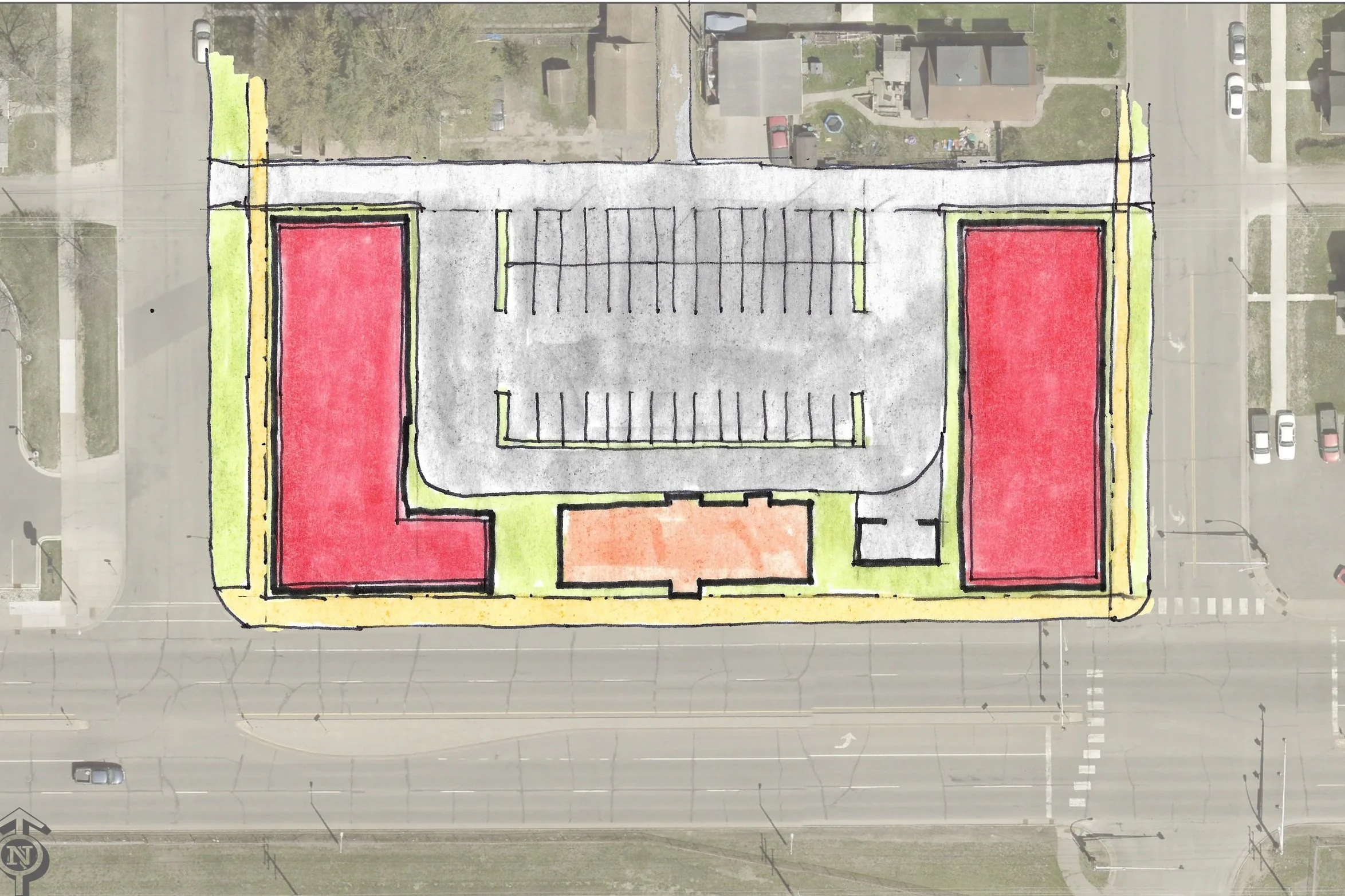The Cost of Auto Orientation
In the United States we've proceeded for sixty years with reconfiguring our public spaces to accommodate the automobile. The built in assumption of this approach, especially when it comes to commercial property, is that the more cars driving by the better. What we've overlooked in our haste to "modernize" is the lower return on investment we get from this approach, even under ideal conditions. Today we need the humility to acknowledge that our ancestors -- who built in the traditional style -- may have known what they were doing after all.
Highway 210 runs east/west through downtown Brainerd. In the hierarchical road system, it is the top of the pyramid and would be classified in most places as a "major arterial". It is designed as a STROAD (a street/road hybrid), attempting to apply highway design standards to what otherwise would be an urban street. In doing so, it has dramatically transformed the land use pattern of the area.
The picture below highlights two blocks that front the highway corridor. The one on the left, which we've labeled "old and blighted", is a block that has retained its traditional development pattern. To the right we have identified the "shiny and new" area, the block that has recently been transformed to an auto-oriented development style, to the glee of city officials and local economic development advocates. In between is a hybrid of the two; part traditional and part auto-oriented.
The old and blighted area is a collection of run down, marginal establishments. There are two liquor stores, a pawn shop, a barber shop, a bankruptcy attorney, a campaign headquarters, a retail establishment, a cafe and a vacant building. This is not a desirable area. If the adjacent highway didn't already ensure decline, local "improvements" have degraded what little pedestrian connectivity may have existed to the adjacent areas. None of it that remains is easy, natural or inviting. In the community's eyes, this is an area that is waiting to redevelop, to transform itself fully into an auto-oriented pattern. That transformation has begun; note that the very westerly building, which is a liquor store, has turned two lots into a parking lot.
By contrast, the shiny and new area contains only one business, that being a new Taco John's drive through fast food restaurant. The modern facility contains two drive-through lanes, good access to the adjacent streets and all the parking that would ever be needed. They've done on-site stormwater retention (the environmentalists applaud) and modern signage. It meets all of the city's design and zoning codes. The restaurant replaced some buildings that were, themselves, part of an evolution from the original, traditional development to the auto-oriented. With the new Taco John's, the transformation is complete.
If there was any question regarding the public's opinion on these two lots, the city of Brainerd's comprehensive plan specifically calls for the transformation of areas that we've labeled "old and blighted" into "shiny and new". The city has designated this area General Commercial, expressing a desire to see the development along this corridor become highway-oriented. This they describe on page 93 of their plan:
General Commercial
The purpose of this category is to identify portions of Brainerd that should contain general retail commercial uses adjacent to the arterial highway system. The intent of this designation is to provide areas for highway-oriented businesses. Consequently, having a strong general commercial base in the city helps the downtown as well. Having a strong highway commercial area helps draw consumers to the city and provides for a healthy downtown. Examples of these could include highway-oriented businesses such as fast food restaurants, convenience stores, gas stations and other auto-oriented businesses as well as a number of large retailers.
In that definition of General Commercial, it is stated that a "strong highway commercial area....provides for a healthy downtown." The problem is that "strong" and "highway commercial" are -- in almost all cases -- mutually exclusive terms. The numbers prove the point in this case.
The eleven old and blighted lots -- some of the most undesirable commercial property in the city -- arranged in the traditional development pattern along the incompatible, major arterial of Highway 210 have a combined tax base of $1,136,500:
To compare, the Taco John's property -- the one that is not only shiny and new but configured precisely as the city of Brainerd desires the old and blighted properties to someday be -- has a total valuation of only $803,200.
At its nastiest and most decrepit, fighting the negative auto traffic speeding by and the absence of pedestrian connectivity, lacking all natural advantage from the neighboring land uses that would ideally accompany a traditional neighborhood design, the old and blighted traditional commercial block still outperforms the new, auto-oriented development by 41%.
Imagine how much more valuable this traditonal block would be if the businesses were simply given some relief from the speed of the STROAD-induced traffic and/or provided some connectivity to the adjacent neighborhood, two things that could be done far cheaper than the millions the city has spent to make this area the dominion of cars.
Imagine how much more prosperous we would all be if we started building Strong Towns.
Postscript: We updated these numbers in 2014. The Taco John's had dropped by nearly $200,000 in value and is now outperformed by the old and blighted block by 78%. I just checked the county's data and discovered that the building has dropped by another $20,000. To add insult to injury, the Taco John's received a 26-year Tax Increment Financing subsidy that expires in 2033. At this rate, there will be no value left by the time the city is ready to start collecting taxes. That kind of rapid drop off in valuation is consistent with what we've seen with this type of development in other cities.









Even just a little bit of snow can reveal a lot about the vulnerability of the suburban development pattern.